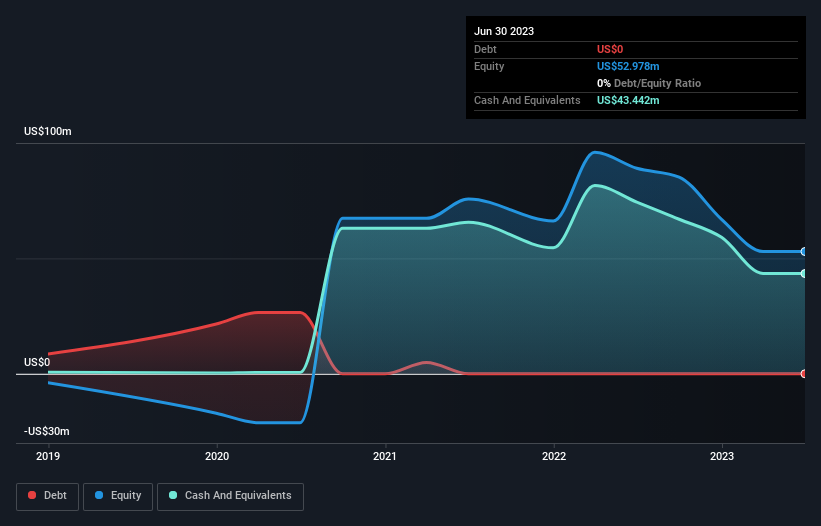
Even when a business is losing money, it's possible for shareholders to make money if they buy a good business at the right price. For example, biotech and mining exploration companies often lose money for years before finding success with a new treatment or mineral discovery. But while history lauds those rare successes, those that fail are often forgotten; who remembers Pets.com?
So should Gencell (TLV:GNCL) shareholders be worried about its cash burn? In this report, we will consider the company's annual negative free cash flow, henceforth referring to it as the 'cash burn'. We'll start by comparing its cash burn with its cash reserves in order to calculate its cash runway.
See our latest analysis for Gencell
Does Gencell Have A Long Cash Runway?
A company's cash runway is calculated by dividing its cash hoard by its cash burn. When Gencell last reported its balance sheet in June 2023, it had zero debt and cash worth US$43m. Looking at the last year, the company burnt through US$30m. Therefore, from June 2023 it had roughly 17 months of cash runway. That's not too bad, but it's fair to say the end of the cash runway is in sight, unless cash burn reduces drastically. The image below shows how its cash balance has been changing over the last few years.

How Well Is Gencell Growing?
Some investors might find it troubling that Gencell is actually increasing its cash burn, which is up 22% in the last year. But looking on the bright side, its revenue gained by 67%, lending some credence to the growth narrative. Of course, with spend going up shareholders will want to see fast growth continue. It seems to be growing nicely. Of course, we've only taken a quick look at the stock's growth metrics, here. This graph of historic revenue growth shows how Gencell is building its business over time.
Can Gencell Raise More Cash Easily?
Even though it seems like Gencell is developing its business nicely, we still like to consider how easily it could raise more money to accelerate growth. Generally speaking, a listed business can raise new cash through issuing shares or taking on debt. One of the main advantages held by publicly listed companies is that they can sell shares to investors to raise cash and fund growth. We can compare a company's cash burn to its market capitalisation to get a sense for how many new shares a company would have to issue to fund one year's operations.
Since it has a market capitalisation of US$40m, Gencell's US$30m in cash burn equates to about 75% of its market value. That's very high expenditure relative to the company's size, suggesting it is an extremely high risk stock.
So, Should We Worry About Gencell's Cash Burn?
On this analysis of Gencell's cash burn, we think its revenue growth was reassuring, while its cash burn relative to its market cap has us a bit worried. Looking at the factors mentioned in this short report, we do think that its cash burn is a bit risky, and it does make us slightly nervous about the stock. On another note, we conducted an in-depth investigation of the company, and identified 3 warning signs for Gencell (1 shouldn't be ignored!) that you should be aware of before investing here.
If you would prefer to check out another company with better fundamentals, then do not miss this free list of interesting companies, that have HIGH return on equity and low debt or this list of stocks which are all forecast to grow.
New: Manage All Your Stock Portfolios in One Place
We've created the ultimate portfolio companion for stock investors, and it's free.
• Connect an unlimited number of Portfolios and see your total in one currency
• Be alerted to new Warning Signs or Risks via email or mobile
• Track the Fair Value of your stocks
Have feedback on this article? Concerned about the content? Get in touch with us directly. Alternatively, email editorial-team (at) simplywallst.com.
This article by Simply Wall St is general in nature. We provide commentary based on historical data and analyst forecasts only using an unbiased methodology and our articles are not intended to be financial advice. It does not constitute a recommendation to buy or sell any stock, and does not take account of your objectives, or your financial situation. We aim to bring you long-term focused analysis driven by fundamental data. Note that our analysis may not factor in the latest price-sensitive company announcements or qualitative material. Simply Wall St has no position in any stocks mentioned.
About TASE:GNCL
Gencell
GenCell Ltd. engages in the development and production of fuel cell-based energy systems.
Moderate with adequate balance sheet.
Market Insights
Community Narratives



